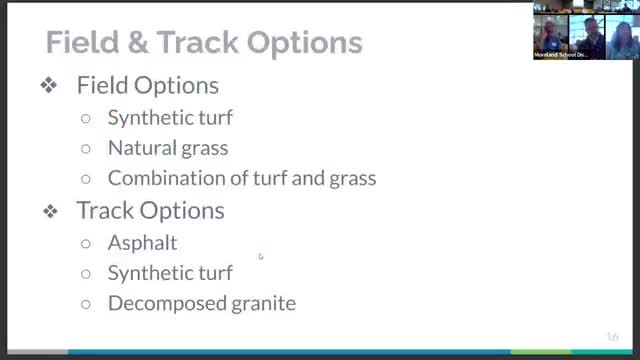School District evaluates synthetic turf versus natural grass for athletic fields
June 03, 2025 | Moreland, School Districts, California
This article was created by AI summarizing key points discussed. AI makes mistakes, so for full details and context, please refer to the video of the full meeting. Please report any errors so we can fix them. Report an error »

The Moreland School District's recent Board Study Session on May 27, 2025, focused on the critical decision of whether to implement synthetic turf or natural grass for school fields, a topic that resonates deeply with the community's needs for safe and sustainable play areas for children.
During the session, district architect Stephanie Duranal presented a thorough comparison of the benefits and drawbacks of both options. Natural grass, while aesthetically pleasing and environmentally beneficial—absorbing carbon dioxide and supporting biodiversity—comes with higher maintenance costs and durability challenges. Duranal noted that natural grass requires regular watering, mowing, and pest control, which can strain resources, especially in California's dry climate. Additionally, the wear and tear from heavy use by students can lead to muddy conditions, complicating playability.
Conversely, synthetic turf offers lower maintenance requirements and year-round usability, making it an attractive option for schools with high foot traffic. It eliminates the need for irrigation and pesticides, addressing environmental concerns. However, the initial installation cost is significantly higher, and there are ongoing debates about player safety, particularly regarding knee injuries associated with synthetic surfaces.
The discussion also touched on the potential for different types of grass and turf infills, including newer materials that mitigate some of the drawbacks of traditional synthetic options, such as odor and heat retention. The board emphasized the importance of gathering community feedback before making a final decision, indicating that this choice will directly impact the quality of play spaces for students.
As the district moves forward, it will consider the feedback from this session to guide its decision-making process. The outcome will not only shape the physical landscape of the schools but also reflect the community's commitment to providing safe and enjoyable environments for its children.
During the session, district architect Stephanie Duranal presented a thorough comparison of the benefits and drawbacks of both options. Natural grass, while aesthetically pleasing and environmentally beneficial—absorbing carbon dioxide and supporting biodiversity—comes with higher maintenance costs and durability challenges. Duranal noted that natural grass requires regular watering, mowing, and pest control, which can strain resources, especially in California's dry climate. Additionally, the wear and tear from heavy use by students can lead to muddy conditions, complicating playability.
Conversely, synthetic turf offers lower maintenance requirements and year-round usability, making it an attractive option for schools with high foot traffic. It eliminates the need for irrigation and pesticides, addressing environmental concerns. However, the initial installation cost is significantly higher, and there are ongoing debates about player safety, particularly regarding knee injuries associated with synthetic surfaces.
The discussion also touched on the potential for different types of grass and turf infills, including newer materials that mitigate some of the drawbacks of traditional synthetic options, such as odor and heat retention. The board emphasized the importance of gathering community feedback before making a final decision, indicating that this choice will directly impact the quality of play spaces for students.
As the district moves forward, it will consider the feedback from this session to guide its decision-making process. The outcome will not only shape the physical landscape of the schools but also reflect the community's commitment to providing safe and enjoyable environments for its children.
View full meeting
This article is based on a recent meeting—watch the full video and explore the complete transcript for deeper insights into the discussion.
View full meeting
